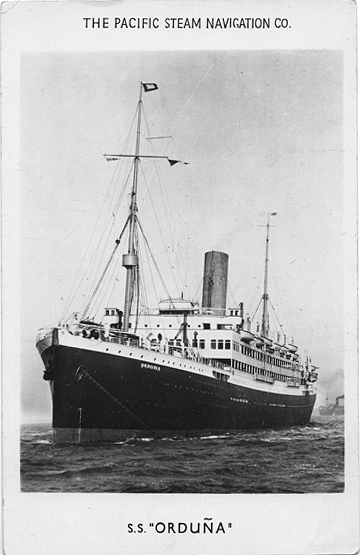2 PORT DETACHMENT,
ROYAL ENGINEERS, PORT SAID 1950-51
As Remembered
By 22314672 Charles A. Otter
On leaving Pinefield
Camp, Elgin, Morayshire, Scotland in March 1950 we travelled by train to Liverpool,
staying two nights in Seaforth Barracks because the ship was not ready for
us. We were finally taken by lorry to the docks to board the S.S. Orduna.
I can remember being shown around the ship and in particular the deck with
all the hooks above to hang your hammock on.
The Pacific
Steam Navigation Co,
S.S. Orduna
|
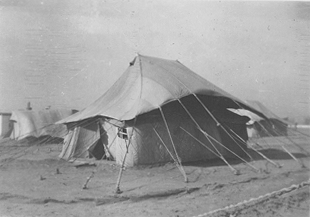
My tent - when the sandstorm
hit us
|
We were soon on our
way and I remember seeing the Rock of Gibraltar upon entering the Mediterranean.
We stopped for a short while at Malta but were not allowed ashore. The smell
was awful as we approached Egypt and disembarked onto the RASC ‘ Z’
craft for 156 Transit Camp where we stayed for two weeks. We were then taken
to the harbour and the ferry to Port Said where a lorry was waiting to take
us to our permanent camps. Along the way we stopped for a meal at Ismailia
and then arrived at a large camp surrounded by barbed wire, I can’t
remember the name of the place but possibly it could have been Fanara or Fayid.
The Guard Room informed us that there was no room for us in the camp and told
us that we would have to stay in a couple of tents located outside the perimeter,
only entering the camp for meals and washing. We spent our days crossing the
Sweetwater Canal and going through a native village with camels, donkeys,
goats and very unfriendly people, and onto the Great Bitter Lake.

Our Billet - 2 Port Detchment,
Port Said
|
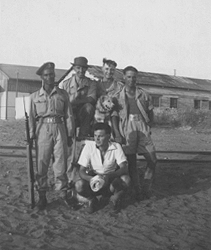
I'm on the r& Mauritian
guard is on the left
|
After about three
weeks we were told to report to the Guard Room where a lorry would be waiting
to take us to our permanent postings. Some were dropped off at various places,
whilst myself and two others went the full distance back to Port Said to 2
Port Detachment Royal Engineers. Our accommodation was basic on the docks
with a five foot wall around it and an outside cold shower with many lizards.
A captain and a sergeant were in charge of us.

Myself on a gun on the
docks
|

My best mate with two native
workers
|
| 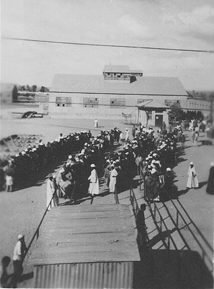
Leaving work
|
Ship coming
through the Canal
Searchlight
box on front of the ship
|
Passenger
ship "Chusan" refueling at Port
Said on
her maiden voyage to Australia
|
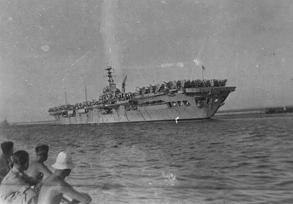
Aircraft carrier entering
the Suez Canal
|
Our off-duty time
was spent at the Britannia Club in Port Said and down at the statue of Ferdenand
de Lesseps at the entrance of the Canal to catch the sea breezes. That was
until Col. Nassar came on the scene and then everywhere became “Out
of Bounds” outside the docks. We had our meals at Movement Control (also
on the docks) or at the NAAFI.
Outside
2 Port Detachment & Other
Regt's.
I'm in the front with the dog,
the billet
is on the left
|
N.C.O.'s
Christmas Dinner 1950 - Age 19 years old
2 Port
Detachment, RE, Port Said
|
Time eventually arrived
for us to hand in our rifles and ammo into the stores and board a RASC launch
to take us out into the shipping lanes to wait for the troopship Dunera to
arrive. We could see it coming in as it left the Canal and entered the harbour
in a convoy with other ships at a rate of about eight knots. It never slowed
down and the launch pulled up alongside it and, with the help of some crew
members, we and our kitbags got on board. It seemed like a very dangerous
move.
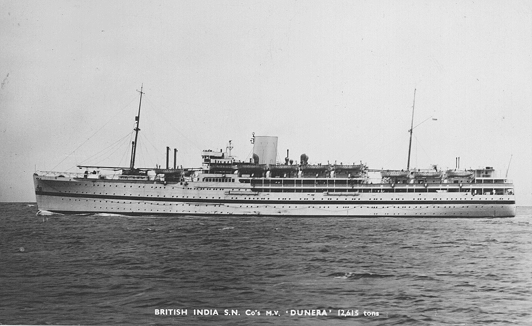
On the journey back
we stopped at Tangiers, North Africa and this time we were allowed to go ashore
for a few hours. On arrival back at Southampton on a cold and rainy morning,
we were taken to Winchester before being discharged.
These are just a few
of my memories from my time in the Canal Zone but I will never forget the
flies and the sandstorms etc.
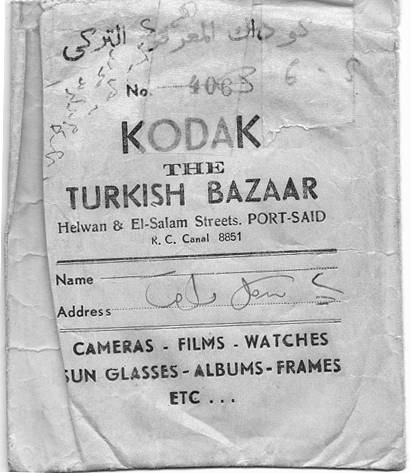
Where my photos
were developed
Charles
writes further:
Leaving from
Liverpool, on entering the Mediterranean Sea I can remember seeing the Rock
of Gibraltar After a few more days we arrived at Malta and were greeted by
all the bum boats trying to sell us all kinds of things. We were not allowed
to go ashore and after a few hours we were on our way again to Egypt.
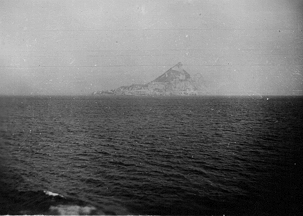
Rock of Gibraltar in the
distance
|
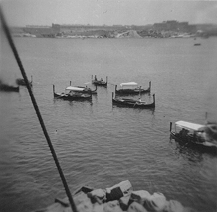
The Bum Boats at Malta
|
|
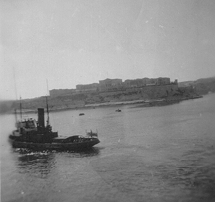
The Tug Boat
at Malta Harbour
|

The Suez Canal
|
Upon arrival in Egypt
we disembarked onto a RASC ‘Z’ craft, taken to Port Fouad and
156 Transit Camp, where we stayed for about 14 days. The first soldiers I
met were two lads from my own home town!
Eventually, we left
the Transit Camp and boarded the ferry to Port Said, where we were put on
lorries to be taken to our camp. Having travelled the full length of the Canal,
stopping a various camps along the way, it turned out that no one wanted us,
so we were taken back to Port Said and 2 Port Detachment, Royal Engineers.
2 Port Detachment
had a captain in charge with a sergeant and two other sappers. All the cargo
ships used to drop anchor and swing round with the stern facing the quay about
50 yards away and then tied up with ropes. They had to do it this way as the
water was not deep enough for the larger ships. Two ships – the Snowdon
Smith and the Humphrey Gale – were L.S.T.’s which were flat-bottomed
and therefore they could discharge their cargo (mostly vehicles) straight
onto the quay. We were often invited onto these cargo ships for a drink in
the evenings.
All R.E.
stores were marked with a brown triangle. These were unloaded into barges
to be brought ashore by steam cranes on tracks.
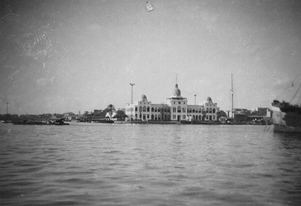
The Canal Company Buildings
|
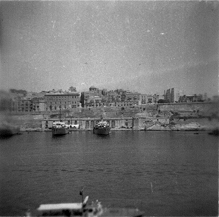
Two Royal Navy ships tied
up at Port Said
|
| 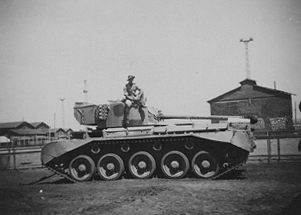
Myself on
a tank in the docks
|
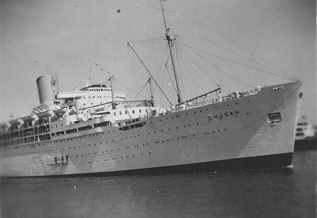
Passenger ship on her way
to the Med
|
We often
visited the Britannia Club in Port and would always be stopped by traders
trying to sell us their goods. I did get measured for a two-piece suit, which
was ready in two days, and was a perfect fit. I wore it for years so was a
good buy.
Most of my
time in the Canal Zone was OK but also some not so good like when I ended
up in the Sick Bay with an insect bite on my wrist. My hand and fingers swelled
up to about twice their size and I also had another bite just under my right
eyebrow, making my face also swell up. I was treated with injections and pills
for about ten days. The bite on my face still often itches even to this day
and the one on my wrist left a large scar.
We used to
take our washing to the dhobi on our way to work and watch them as they sprayed
a mouthful of starch onto the washing before ironing it and pick it up on
our way back to our billet after work. They always did a good job of it. We
also had a barber come to the billet once a week.
Everything
changed when a “State of Emergency” was declared and everywhere
in Port Said became “Out of Bounds” – except the docks
Back
to RE
Back
to Army Units
Back
to Canal Zoners Memories
Back
to Main Page

